
Sometimes the simplest posts are the hardest to write. What began as a short and sweet look back at the year has, just from thinking on it, morphed into something more. As I stared at the images for this post, two questions came into my mind. Why is this little forest fragment even here. And what if it were not?

Urban forests are often the leftovers, so to speak, after development proceeds on all the “best” sites. The fact that some places are largely undevelopable due to rugged topography or flood-prone soggy bottomlands, may also mean they are (or were) rich and diverse habitats. That’s true for this forest – at its core is the wide floodplain of Beargrass Creek, with towering sycamore and cottonwood trees rising from rich muck soils. Like most urban waterways, the creek itself no longer floods over this bottomland, having been locked into a permanent deep channel almost ninety years ago. But the floodplain still fills with water from November to April; it’s one of the largest bottomland forests with ephemeral wetlands remaining in this urban area.

At its western end the forest starts with a steep drop-off, into a “karsty” area of small sinks, and springs that flow into seasonal waterways across the floodplain. Streamside, Cave, and Zigzag salamanders depend on the limestone cavities and small breeding pools at the head of the springs.
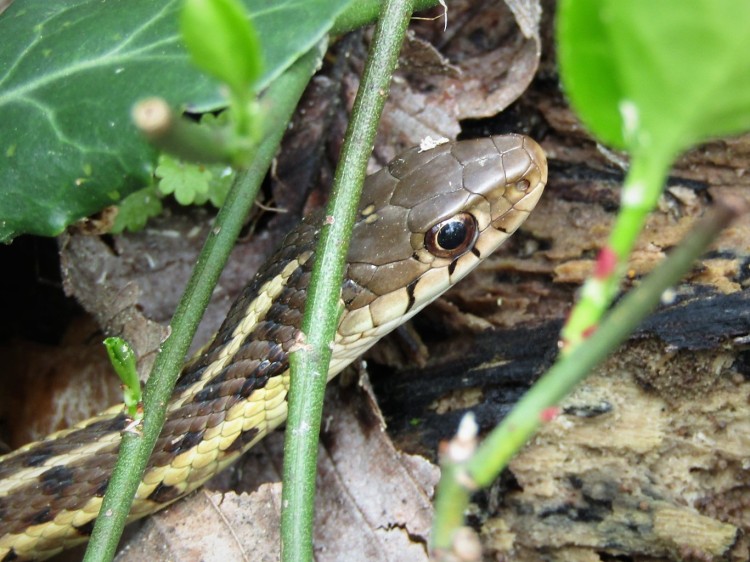
Despite the effects of benign neglect, this eighty acres is relatively rich in both realized and potential habitat. But it’s just a fragment, after all. One of the most basic and well studied patterns in ecology is the “Species-Area Relationship” – which means, in a nutshell, the larger a natural area the more species it supports. No matter how much one restores the habitat of a fragmented forest, it can never uphold the diversity of a large contiguous area of woodland. Knowing that, it’s all the more astonishing to me that so many species either remain, or have found their way here recently.

One recent arrival, the Zebra swallowtail butterfly, can be directly attributed to habitat improvement. This species larval food plant, the Pawpaw, has been relatively abundant here for at least a few decades. But Pawpaw groves were mostly centered in the very shady, Bush honeysuckle overgrown forest interior. Butterflies need sunny flowery places to nectar, not too far distant from their larval foodplants. The first Zebra swallowtail I saw here was nectaring on a patch of pink and yellow lantana in the LNC sensory garden. The second one was a larva chewing on the leaves of a newly planted Pawpaw tree at the edge of the garden. This past summer, for the first time, I saw Zebra swallowtails in several locations in the forest, especially nectaring on Buttonbush (as described in my post from 7/21 “The Buttonbush”). I was inspired to buy and plant, with the help of the forest stewards, twenty Buttonbushes in the bottomlands this winter – future nectar for forest bees and butterflies.

Some species, like the native Wild onion, Allium canadense, just seem to reappear when conditions improve for them. Hillsides that were previously covered with Bush honeysuckle saw an uprising of these delicate, pink flowered onions with grass-like leaves a couple years after the shrubs were removed.

What if this forest were not here? My second question can be answered by one image – a Blue-gray gnatcatcher. This tiny neotropical migrant and its fellow travellers – warblers, kinglets, thrushes, tanagers, vireos, cuckoos, flycatchers, grosbeaks, sparrows, wrens….all need safe places to rest and feed during migration. Most of them just pass through, but a few, including the gnatcatcher, stay to nest.
Though the main cause of the steep decline in neotropical migrants is deforestation in their winter habitats, migration is also hazardous. The fact that these woods fill with foraging migrants in spring and fall testifies to their high value. A fragment like this is just a tiny piece in the patchwork that eastern woodlands have become, but it’s connectivity that matters. Urban forests often get a higher share of migrating birds since good habitat is scarce.

In contrast, many woodpeckers don’t migrate, finding their insect food, and nesting habitat year round under bark and in the heart of dead trees. This forest, relative to most, has a huge supply of declining and down trees, with many more on the way. Not surprisingly it’s also a woodpecker paradise. But woodpecker incentives drop off sharply at the edge of the forest, since dying and dead trees, and rotten stumps are mostly anathema in urban settings like our own yards. Obviously we don’t want them falling on a structure, but I think it goes beyond that to the notion of what’s “tidy”. Rarely is even a broken off tree, posing no danger to anyone, left standing in a yard.
I often indulge in fantasies of habitat corridors branching out from this forest, connecting it to other urban natural spaces. Scrolling around, I learned there’s name for this sort of thinking – reconciliation ecology. Formulated by Michael J. Rosenzweig in 2003, reconciliation ecology is “the science of inventing, establishing and maintaining new habitats to conserve species diversity in places where people live, work and play.” Easier said than done, with urban property so minutely parcelled out into little personal plots called yards. As with the dead tree example, learning to think differently about one’s property, and then enduring neighborly social pressure to conform is no easy matter! For those who are brave, there’s an organization that will support your choices: wildoneslouisville.org (wildones.org).

In the fragment, June’s heat signals the arthropod season has come. Mosquitos being one the most abundant of this phylum, it also means the forest is less inviting to humans. Birds however are busy hunting insects of all sorts, but especially caterpillars to stuff into the mouths of their young.

One group of flying creatures that eats mosquitos as both larva and adult are the dragonflies and damselflies. Mysteriously they are becoming more abundant in the forest, though there is little standing water through the summer for eggs to be laid in.
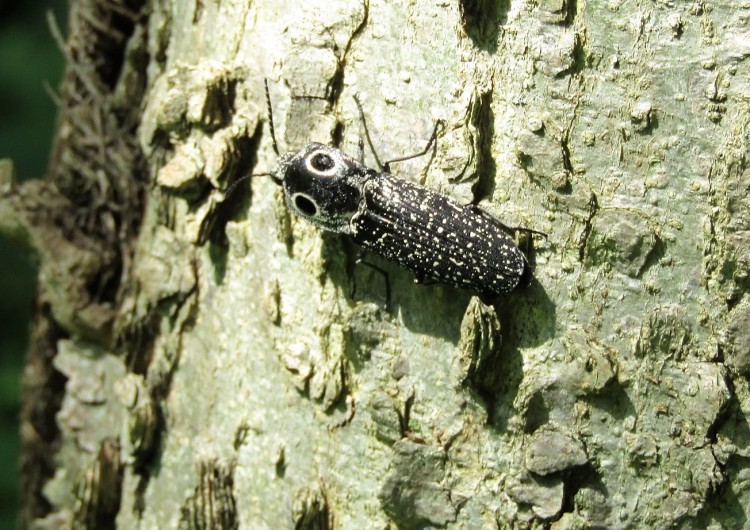

As the summer heat and drought deepened, one of my favorite plants was thriving and even expanding its reach. This stand of River oats (Chasmanthium) came from seed scattered a few years ago, as invasive shrub removal and ash tree death turned this into an open sunny hillside. Like a mini bamboo, the oats create a dense stand of great ground level cover, and produce abundant seed for scattering in other places.

By late summer, hummingbirds and their fledged young began to wander through, plying the abundant Spotted jewelweed blooms. Despite drought stress the jewelweed held up for the most part, by wilting heavily in the heat of the day and recovering overhight.

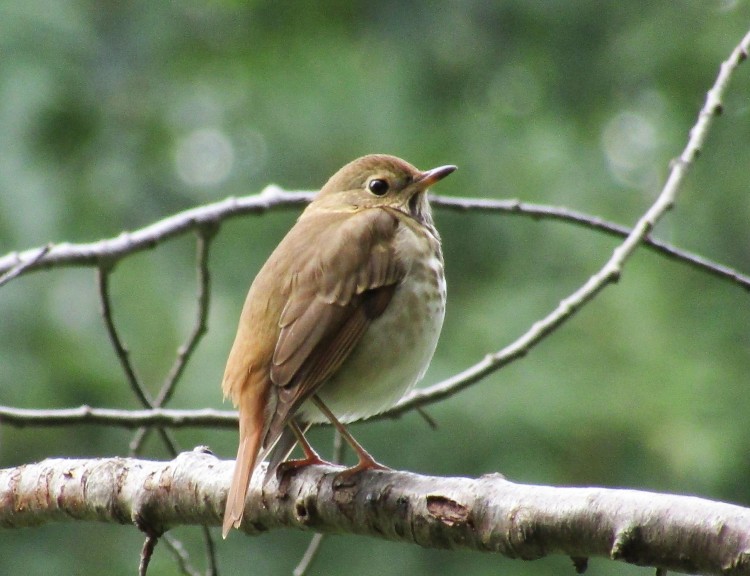
October brought the return of migrating birds…

…and overnight, the woods filled with skulking winter wrens – their little kip-kip toy bird calls the only notice of an invasion.
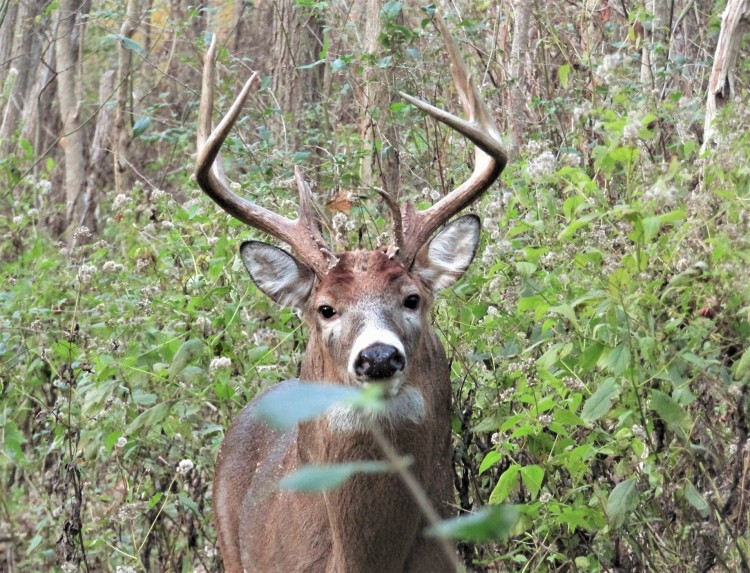


The last image is from yesterday, as winter rains fill an abandoned trailbed in the process of being recovered. Down wood from dead ash trees is being placed in the channel to slow and divert the water movement.
“The only thing constant is change” Heraclitus
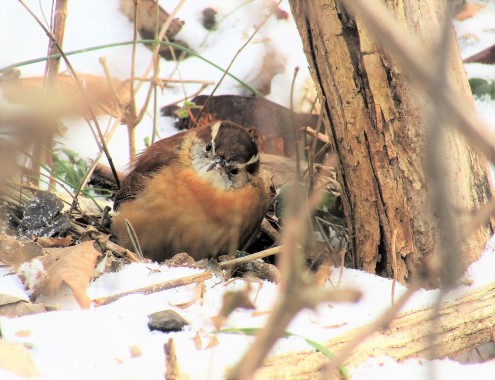
Serendipity
Wonderful post, as always although I had to look up more words than usual LOL. We enjoyed a short walk in the woods New Year’s day, great start to 2020!
LikeLiked by 1 person
oneforestfragment
Thank-you! I’m glad you had to look up words – would never want to talk down to my readers. I look at a lot of research and use the thesaurus a good bit while writing.
LikeLike
Phyllis Fitzgerald
Enjoyed the post & recent history. My family hiked the preserve a couple of weeks ago & wondered why so many recently cut trees; are they ash trees infected to Emerald Ash Borer, or taken down to prevent more infestation?
LikeLiked by 1 person
oneforestfragment
Those were dying or dead ash trees cut down by KY Nature Preserves – since they were so close to the trail they posed a real hazard. More and more ashes will be falling or dropping large limbs, I have seen several big ones that came crashing down over the last couple months.
LikeLike
shoreacres
This is one of the nicest and most educational retrospectives I’ve read — thank you.
I thought you’d enjoy seeing a couple of turtles I encountered at Christmas time. I’m fairly sure they’re red sliders, although I couldn’t get a decent look at their heads. They live in a pond that’s part of an interesting place called Laffite’s Cove Nature Preserve: a residential development on Galveston Island designed as to serve as a nature preserve as well. It’s a birding hot spot during migration, due to a combination of ponds, woods, and so on, and those who buy a home automatically become a member of the preserve, and are assessed for its development and maintenance. It’s a wonderful place.
LikeLike
shoreacres
Here’s a link to the nature society website. It’s a great model.
LikeLike
rewilder2020
Fantastic look back on the year. Particularly liked the photo of the hermit thrush. We watched a barn owl hunting in the mist over our field yesterday, but doubt it caught anything as handsome as a northern flicker. Thank you for taking the time and trouble to keep us informed and inspired.
LikeLiked by 1 person